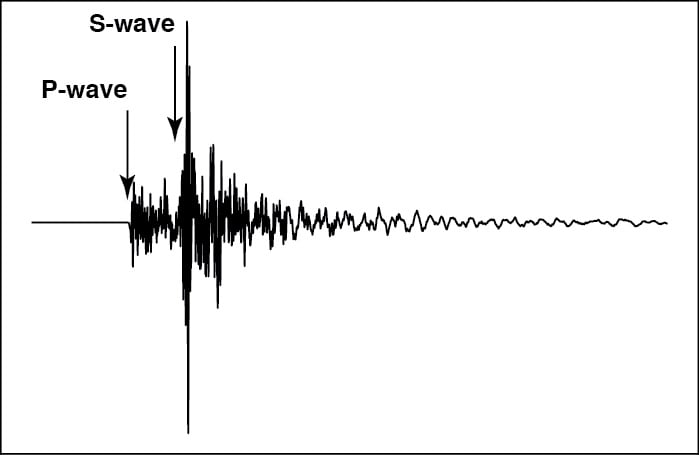Damage and Shaking
Seismologists study earthquakes by looking at the damage that was caused and by using seismometers. A seismometer is an instrument that records the shaking of the Earth's surface caused by seismic waves. The term seismograph usually refers to the combined seismometer and recording device.
The First Earthquake Detectors
The first known earthquake detector was invented in 132 A.D. by the Chinese astronomer and mathematician Chang Heng. He called it an "earthquake weathercock."
Each of the eight dragons had a bronze ball in its mouth. Whenever there was even a slight earth tremor, a mechanism inside the seismograph would open the mouth of one dragon. The bronze ball would fall into the open mouth of one of the toads, making enough noise to alert someone that an earthquake had just happened. Imperial watchmen could tell the direction the earthquake came from by seeing which dragon's mouth was empty.

In 136 A.D. a Chinese scientist named Choke updated the meter and called it a "seismoscope." Columns of a viscous liquid replaced the metal balls. The height the liquid washed up the side of the vessel indicated the intensity and a line joining the points of maximum motion denoted the direction of the tremor.
Seismographs
Most seismographs today are electronic, but the basic design and components are still the same: a drum with paper on it, a bar or spring with a hinge at one or both ends, a weight, and a pen. One end of the bar or spring is bolted to a pole or metal box fixed to the ground. The weight is placed on the other end of the bar and the pen is attached to the weight. The paper-covered drum presses against the pen and turns constantly. When there is an earthquake, everything in the seismograph moves with the Earth except the weight with the pen on it. As the drum and paper shake next to the pen, the pen makes squiggly lines on the paper, creating a record of the earthquake. This record made by the seismograph is called a seismogram.


By studying the seismogram, the seismologist can tell how far away the earthquake was and how strong it was. This record doesn't tell the seismologist exactly where the epicenter was, just that the earthquake happened so many miles or kilometers away from that seismograph. To find the exact epicenter, you need to know what at least two other seismographs in other parts of the country or world recorded. We'll get to that in a minute. First, you have to learn how to read a seismogram.
How Do I Read a Seismogram?
When you look at a seismogram, there will be wiggly lines all across it. These are all the seismic waves that the seismograph has recorded. Most of these waves were so small that nobody felt them. These tiny microseisms can be caused by nearby activities, such as heavy traffic or wind, or by distant sources such as interactions of waves with the ocean floor. They may also be caused by earthquakes that are too small or too far away to be recognized as earthquakes.

So which wiggles are the earthquake? The P wave will be the first wiggle that is bigger than the background signals). Because P waves are the fastest seismic waves, they will usually be the first ones that your seismograph records. The next set of seismic waves on your seismogram will be the S waves. These are usually bigger than the P waves. The waves that arrive between the P and S waves are waves that started out as P waves, but bounced off of features in the Earth or at the surface and arrived at the seismic station a little later.
The surface waves (Love and Rayleigh waves) are the other, often larger, waves marked on the seismogram. They have a lower frequency, which means that waves (the lines; the ups-and-downs) are more spread out. Surface waves travel a little slower than S waves (which, in turn, are slower than P waves) so they tend to arrive at the seismograph just after the S waves. For shallow earthquakes (earthquakes with a focus near the surface of the Earth), the surface waves may be the largest waves recorded by the seismograph. Often they are the only waves recorded a long distance from medium-sized earthquakes.
Where Can I Find Seismic Data?
Many organizations monitor earthquakes throughout the world. The Incorporated Research Institutions for Seismology, or IRIS, provides a data center with thousands of seismic stations. The Seismographs in Schools program is a great place to start. You can search for data from an earthquake using a world map, and find links to stations that recorded it.